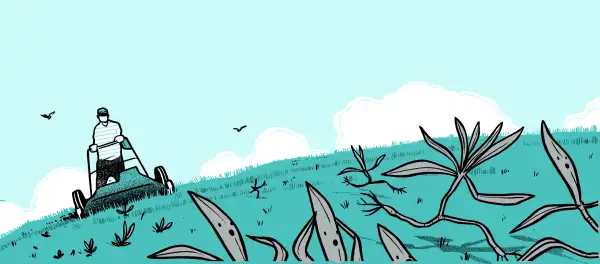4 (Mostly) Cheap and Easy Ways to Green Up Your Grass

Does it feel like the grass really is greener in other people’s yards? Summer’s heat and low rainfall are tough on turf, so neighbors sporting lush lawns this time of year probably have better species of grass, higher-quality topsoil, and automatic irrigation. You, too, can have all that—for perhaps $10,000 or more—with a complete lawn replacement. Or you can try more affordable approaches to keeping your existing grass verdant.
Mow smarter
“Taller grass holds more moisture and stays greener than short grass,” says Mark Schmidt, principal scientist at John Deere. “Plus, it shades the soil, helping to keep the roots wet.” Set your mower deck to three inches (or as high as it will go). Also, inspect the grass right after mowing. Jagged tears indicate that the blade is dull, and these wounds sap moisture from the plants. Get a replacement blade for $10 to $40 or take your mower for a tune-up ($75 to $200), which includes blade sharpening.
Do not feed the plants
When a lawn turns brown, it’s not dead—it’s just gone dormant to save energy for cooler, wetter times. You may be tempted to apply fertilizer and weed control, but if not done right, those chemicals can burn a heat-stressed lawn, says Oregon State University horticulture professor Alec Kowalewski.
Water on schedule
Dragging around the hose and sprinklers to hydrate parched grass may do more harm than good. “Coming in and out of dormancy can kill the lawn,” says John Stier, a playing-field consultant to several National Football League teams. “So don’t water unless you’re going to be superconsistent about watering all season long.” That’s probably not realistic with manual efforts, so either let nature take its course or go for automatic irrigation, a $2,000 to $4,000 expense for which there really isn’t a good low-cost workaround. To maximize your investment, ask the installer to arrange sprinkler heads into zones based on the quirks of your property so that shady, sunny, poorly drained, and sloped areas can get programmed for their own watering needs. Opt for a rain sensor too (around $150), which will override sprinklers when Mother Nature provides irrigation for free.
Aerate in autumn
Whether or not you irrigate, think of lawn restoration as a multiseason project. In the fall, plan to aerate—cutting hundreds of holes to loosen the soil—and top with compost and a mix of grass seed bred for your climate ($500 to $1,000 to hire out the job). Repeat for several seasons, and you’ll gradually improve the soil and grass type, making your lawn more drought-resistant, and yours the greener side of the fence.